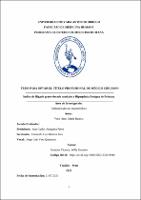Índice de Hígado graso elevado asociado a Hiperplasia Benigna de Próstata
Abstract
Determinar si el índice de hígado graso (IGH) elevado está asociado a Hiperplasia benigna de próstata (HBP) en pacientes del Hospital Belén de Trujillo.
Método: Se realizó un estudio observacional, analítico y transversal en 124 pacientes con diagnóstico de Hiperplasia Benigna de Próstata que presentaron síntomas de tracto urinario inferior evaluados por medio del International Prostatic Score Symptons (IPSS), quienes consultaron al servicio de urología y que además acudieron al servicio de medicina, contando con los exámenes necesarios para la determinación del índice de hígado graso. La prueba T de Student comparó los promedios, se midió asociación entre ambas variables con Chi-cuadrado, y se realizó análisis multivariado por regresión logística.
Resultados: El IHG fue mayor en los pacientes con HBP (58.3 vs 39.2, p<0.001), al igual que la edad, y la gamma-glutamil-transferasa. El IHG elevado (≥40) es un factor asociado independiente de HBP luego de ajustar las variables de confusión (ORa: 8.58, IC95%: 3.07-23.92).
Conclusión: El índice de hígado graso elevado es factor asociado a HBP en pacientes del Hospital Belén de Trujillo. Determine if the elevated fatty liver index (IGH) is associated with benign prostatic hyperplasia (BHP) in patients at the Hospital Belén of Trujillo.
Method: An observational, analytical and cross- sectional study was carried out in 124 patients with a diagnosis of Benign Prostatic Hyperplasia who presented lower urinary tract symptoms evaluated through the International Prostatic Score Symptoms (IPSS) and who consulted the urology service and that they also went to the medical service with the necessary tests to determine the fatty liver index. The T-Student test compared the averages, the association between both variables were measured with Chi-Square and multivariate analysis was performed by logistic regression.
Results: IHG was higher in patients with BPH (58.3 vs. 39.2, p <0.001), as much as age and gamma-glutamyl transferase. High IHG (≥40) is an independent associated factor for BPH after adjusting the confounding variables (ORa: 8.58, 95% CI: 3.07-23.92).
Conclusion: The high fatty liver index is an associated factor for BPH in patients of the Hospital Belén of Trujillo.
Subject
Collections
- Medicina Humana [2969]


